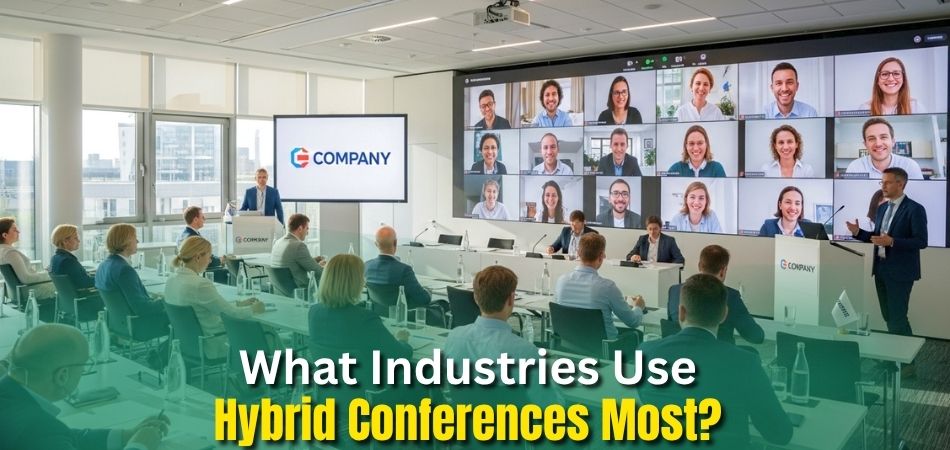Hybrid conferences have transformed the way industries connect, share, and collaborate. In a world where flexibility and accessibility are essential, these events bring together both in-person and online participants under one platform. They have become the preferred choice for organizations aiming to reach larger audiences while saving time and cost.
When discussing what industries use hybrid conferences most, it’s clear that this model suits a wide variety of sectors. From business and education to healthcare and technology, professionals are finding new ways to exchange ideas and expand global connections through this hybrid approach. It bridges geographical gaps and supports meaningful participation from every corner of the world.
As hybrid events continue to redefine modern communication, their influence across industries grows stronger each year. Continue reading to discover which sectors benefit most and why this format is shaping the future of global conferences.
What Industries Use Hybrid Conferences Most?
Hybrid conferences blend virtual and in-person participation, creating flexible environments for global collaboration. They have become vital in modern communication by allowing professionals from different regions to engage without travel limitations. Many upcoming conferences in Canada, the USA, or elsewhere are using this approach to increase accessibility, participation, and knowledge exchange across borders. Here, let’s explore which industries rely most on hybrid conferences and why.
Corporate and Business
The corporate world uses hybrid conferences for product launches, annual summits, and leadership training. This approach reduces costs, allows global collaboration, and ensures company-wide inclusivity. Employees, partners, and clients can participate simultaneously, creating stronger professional connections. Hybrid events also make it easier for international branches to align with company goals in real time.
Education and Research
Educational institutions and research organizations increasingly use hybrid events to host symposiums, academic conferences, and student presentations. This model promotes equal opportunities for scholars worldwide and enhances learning outcomes. Students and faculty can attend virtually or in person, making education more accessible and research collaboration more dynamic and globally connected.
Healthcare and Medical
The healthcare sector adopts hybrid conferences to exchange medical knowledge and train professionals globally. Doctors can attend virtual surgeries or live sessions led by experts without leaving their hospitals. This ensures continuous education, access to global expertise, and improved medical research collaboration, ultimately enhancing healthcare delivery and innovation worldwide.
Technology and IT
Technology and IT industries lead in implementing hybrid models for product demonstrations, coding events, and global expos. These sectors thrive on innovation and rely on digital platforms to connect developers, engineers, and clients. Hybrid setups offer interactive experiences, live product testing, and instant feedback, helping companies showcase technological progress to diverse audiences.
Nonprofits and Government Sectors
Nonprofits and public agencies benefit greatly from hybrid events for awareness campaigns and global discussions. They can reach larger audiences, host international donors, and involve communities remotely. Hybrid setups reduce costs and ensure inclusivity, allowing participants from low-resource regions to join and contribute meaningfully to important policy and social dialogues.
Across industries, hybrid conferences redefine professional communication by merging inclusivity and efficiency. They connect individuals regardless of location, enabling continuous learning and collaboration. As technology advances, these conferences will remain an essential format for knowledge sharing, engagement, and global connection across diverse professional sectors.
Why Hybrid Events Are Gaining Popularity Worldwide?
Hybrid events are transforming the way professionals connect, share, and collaborate. By merging physical and virtual participation, they create inclusive environments where location no longer limits involvement. The global shift toward digital interaction after the pandemic has made hybrid formats not just convenient but essential for sustainable, engaging, and large-scale professional gatherings. Let’s take a closer look at the key reasons behind their growing popularity.
Global Accessibility
Hybrid events make it possible for participants from around the world to join without expensive travel or time constraints. Attendees can connect live, network virtually, and still enjoy the benefits of in-person interaction. This inclusivity has opened doors for international collaboration, ensuring that global voices are represented across industries and professional discussions.
Flexibility and Convenience
Flexibility is one of the strongest appeals of hybrid events. Participants can choose between attending physically or virtually, depending on availability or preference. Organizers can also adjust sessions, provide on-demand recordings, and extend event access beyond the live date, making the experience more participant-centered and efficient for both sides.
Cost-Effectiveness
Hybrid events reduce the high costs associated with traditional conferences. Organizations save on venue expenses, logistics, and accommodation, while attendees avoid travel-related costs. This financial efficiency allows companies to reallocate budgets toward technology, marketing, and content improvement, ensuring greater reach and engagement without compromising event quality.
Sustainability Focus
Environmental awareness is another major factor behind the rise of hybrid events. Fewer flights, printed materials, and on-site logistics mean a lower carbon footprint. Businesses and institutions that prioritize sustainability now view hybrid models as a responsible choice for reducing environmental impact while maintaining global participation and inclusivity.
The continuous popularity of hybrid events reflects a shift in how people value connection and convenience. By balancing accessibility, cost, and sustainability, these events have redefined global networking. From business expos to educational summits, the hybrid model is shaping a future where participation is truly borderless and impactful.
Comparing In-Person, Virtual, and Hybrid Models
Every event format brings its own strengths and challenges. As global participation increases, organizers now focus on flexibility, engagement, and efficiency to meet diverse audience needs. Understanding the differences among in-person, virtual, and hybrid conferences helps professionals make informed choices and design meaningful experiences that maximize participation and communication across varied industries.
Now, let’s explore each model in detail to see how they differ in purpose and execution.
In-person Conferences
In-person events are known for their high engagement and real-time connection. They create immersive environments where attendees can build stronger professional relationships through face-to-face interaction, networking, and hands-on collaboration. Despite their unmatched energy and authenticity, they involve higher expenses, travel requirements, and limited accessibility for international participants who may find attendance challenging due to distance or cost.
Virtual Conferences
Virtual conferences allow participants to connect from anywhere in the world through online platforms. They are cost-effective, time-efficient, and ideal for global participation. Organizers can record sessions, conduct live chats, and offer post-event replays to extend learning opportunities. However, virtual events often struggle to replicate the emotional connection, spontaneous networking, and personal engagement found in traditional face-to-face gatherings.
Hybrid Conferences
Hybrid conferences merge the strengths of both in-person and virtual formats, allowing flexible participation for global audiences. They enable physical attendees to enjoy real-time interactions while remote participants engage through live streaming and digital tools. The impact of hybrid conferences is immense, offering inclusivity, scalability, and wider reach. Still, managing seamless technology integration and audience engagement can pose logistical challenges.
Comparison Table
| Event Type | Advantages | Limitations | Best Use Case |
| In-person | Builds strong networking and relationships | High cost and limited accessibility | Local seminars and workshops |
| Virtual | Cost-effective and highly flexible | Less personal engagement | Webinars and online training |
| Hybrid | Broader reach with interactive participation | Requires advanced tech setup | International and global conferences |
Each model offers valuable benefits tailored to different goals and audiences. In-person events deliver authentic networking, virtual events ensure convenience and affordability, while hybrid models balance both worlds. Choosing the right approach depends on the desired level of engagement, audience scale, and available resources to achieve an effective, inclusive event experience.
Challenges Faced by Industries Using Hybrid Conferences
While hybrid conferences have reshaped global communication, they come with practical challenges that industries must address. Managing both in-person and virtual experiences simultaneously requires strategic planning, reliable technology, and flexible coordination. Here are the main challenges the industry faced using hybrid conferences.
Technical Barriers
One of the biggest hurdles is ensuring stable connectivity and smooth software integration. Poor internet connections, incompatible platforms, and audio-visual glitches can disrupt sessions and affect audience satisfaction. For example, educational institutions hosting international research events often face connection delays or mismatched time zones, impacting participation and engagement quality during live sessions.
Audience Engagement
Keeping both in-person and virtual attendees equally engaged is another major challenge. Organizers must balance live interaction with digital tools like polls and Q&A sessions to maintain interest. The corporate sector often struggles here, as remote participants may feel disconnected during live discussions or networking activities happening onsite. Ensuring inclusivity requires continuous interaction planning.
Logistical Coordination
Coordinating schedules, managing venues, and handling technical setups across two formats can be complicated. Hybrid events demand additional staff to monitor live streaming, manage chat platforms, and support attendees both onsite and online. Healthcare conferences, for instance, face scheduling issues when aligning physical demonstrations with simultaneous virtual broadcasts for global audiences.
Budget and Resource Constraints
Although hybrid events save travel costs, they often require significant investment in technology, skilled technicians, and digital infrastructure. Smaller organizations, nonprofits, and educational institutions sometimes struggle to meet these costs. Balancing quality with affordability becomes a recurring issue, especially when organizers aim to deliver a professional experience across multiple time zones.
So, hybrid conferences bring remarkable opportunities but also require careful execution. From technical management to audience engagement, every challenge demands attention and expertise. By understanding these hurdles, industries can refine their strategies and ensure smooth, inclusive, and effective hybrid experiences for participants both onsite and online.
How Nonprofits Benefit From Hybrid Conferences?
Hybrid conferences have opened new doors for nonprofits to connect with communities, donors, and global partners. These events allow organizations to communicate their mission widely without major financial strain. By combining online and in-person participation, nonprofits can expand their outreach, strengthen engagement, and increase awareness across regions. Here is how nonprofits benefit from hybrid conferences.
Wider Outreach and Inclusivity
Hybrid formats help nonprofits reach audiences far beyond local boundaries. Participants who can’t attend in person can still join virtually, ensuring global inclusivity. This allows NGOs to share causes with international donors, volunteers, and media outlets. For instance, a climate action organization can host hybrid awareness summits with participants from multiple continents joining in real time.
Cost Savings and Resource Efficiency
For nonprofits with limited budgets, hybrid conferences are highly cost-efficient. Hosting a smaller physical event while streaming it online saves venue and travel costs. These savings can be redirected toward campaigns or community projects. This approach ensures that essential funds are used effectively while maintaining professional event quality and donor engagement.
Stronger Donor and Volunteer Engagement
Hybrid events give nonprofits a flexible way to interact with their donors and volunteers. Virtual participation options allow donors to attend presentations, fundraising sessions, or impact reports from anywhere. For example, humanitarian organizations can broadcast live updates during relief missions, helping supporters stay informed and connected to the organization’s goals.
Global Collaboration and Partnerships
Through hybrid models, nonprofits can partner with international institutions, experts, and sponsors more easily. Virtual participation enables global panels, discussions, and collaborative planning without the challenges of international travel. Environmental and human rights organizations, for example, can use this model to coordinate global advocacy campaigns with multiple partner institutions simultaneously.
Future Trends in Hybrid Conference Technology
Hybrid conferences continue to evolve with rapid advancements in technology. As industries aim for more immersive, accessible, and sustainable experiences, innovation is reshaping how participants interact and learn. The next generation of hybrid events will combine human connection with intelligent digital tools, creating a seamless environment for engagement, inclusion, and global collaboration. Let’s explore the key trends driving the future of hybrid conferences.
AI-Powered Translation and Automation
Artificial Intelligence is set to make hybrid conferences more inclusive through real-time translation, captioning, and automated scheduling. These tools remove language barriers and improve accessibility for international audiences. Organizers can also use AI-driven analytics to study audience behavior, allowing better content personalization and improved event outcomes across industries and communities.
Immersive AR and VR Experiences
Augmented and Virtual Reality technologies will redefine how people experience hybrid events. Attendees will soon explore 3D venues, interact with digital displays, and participate in simulations from their homes. These tools will enhance learning, product demonstrations, and networking, making hybrid conferences more interactive, engaging, and closer to in-person experiences.
3D Virtual Booths and Interactive Platforms
Future hybrid events will feature virtual booths that replicate real exhibition spaces. Businesses and nonprofits can display products, host live chats, and conduct digital demos with visitors worldwide. This feature creates dynamic engagement for trade shows, education fairs, and corporate expos, allowing remote participants to experience events as if they were physically present.
Focus on Sustainability and Data Analytics
Sustainability will remain a central focus as organizations adopt eco-friendly practices to reduce waste and emissions. Data-driven analytics will also play a vital role, providing organizers with insights into attendee engagement, content effectiveness, and participation trends. These technologies will ensure smarter, greener, and more impactful event planning globally.
The future of hybrid conferences is bright and full of possibilities. With AI innovation, immersive experiences, and data intelligence shaping event design, the line between physical and virtual will continue to fade. These advancements will redefine professional and educational gatherings, making them more inclusive, sustainable, and meaningful for audiences worldwide.
Frequently Asked Questions
Curious to learn more about hybrid conferences and how they’re shaping global events? Here are some common questions readers often ask after exploring this topic. These answers provide simple and clear insights into what makes hybrid events effective, innovative, and valuable for different audiences.
What Makes Hybrid Conferences Different From Traditional Events?
Hybrid conferences combine both in-person and online participation, allowing flexibility for attendees. This setup connects people worldwide without requiring travel. It offers real-time engagement, broader reach, and a balanced experience that traditional face-to-face events cannot always provide.
How Do Hybrid Conferences Improve Accessibility For Participants?
These events break geographical and financial barriers by letting participants join remotely. People from different countries can attend without spending on travel or accommodation. It ensures inclusivity by welcoming diverse voices, including those who may not have access to physical venues.
Can Small Organizations Successfully Host Hybrid Conferences?
Yes, even small organizations can host hybrid events with proper planning and affordable tools. Many online platforms now offer user-friendly options for streaming, registration, and engagement. Starting small and scaling gradually helps maintain quality and manage resources effectively.
What Are Some Effective Ways To Keep Virtual Attendees Engaged?
Interactive polls, live chats, breakout sessions, and Q&A rounds work well for engagement. Organizers can also use digital rewards or networking spaces. The key is to create a sense of connection so virtual participants feel as involved as onsite attendees.
How Do Hybrid Conferences Support Sustainability Goals?
Hybrid formats reduce the need for travel, printed materials, and large venues, lowering carbon emissions significantly. Many organizations adopt digital resources and eco-friendly setups. This approach makes hybrid events a sustainable choice for modern, environmentally conscious industries.
Are Hybrid Conferences Suitable For Educational Institutions?
Absolutely, schools and universities benefit greatly from hybrid models. Students can attend lectures online while others join in person. It promotes flexible learning, enables international collaboration, and allows educators to reach a wider academic audience efficiently.
How Is Technology Expected To Evolve Hybrid Conferences Further?
Future advancements like AI, VR, and real-time translation tools will make hybrid events more interactive and inclusive. These technologies will simplify communication and data analysis. As innovation continues, hybrid conferences will become even more engaging and globally connected.
Concluding Words
The rise of hybrid conferences marks a new era of connection and collaboration across industries. Organizations are no longer limited by distance or budget, as this flexible format enables seamless participation from anywhere in the world. It’s a model built for inclusivity, efficiency, and meaningful global interaction.
When considering what industries use hybrid conferences most, it’s clear that sectors like business, education, healthcare, and technology have adapted quickly. These industries value hybrid models for their ability to expand reach, reduce costs, and enhance engagement among participants from diverse backgrounds and locations.
Looking ahead, hybrid events are set to play an even greater role in shaping the future of communication. As technology advances, these conferences will continue to bridge global audiences and redefine how knowledge and collaboration thrive across industries.








